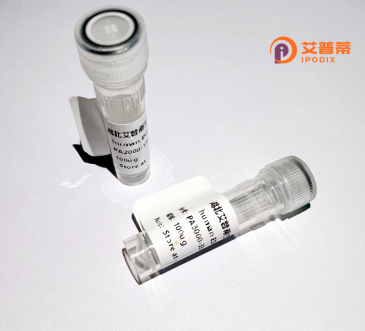
| 纯度 | >90%SDS-PAGE. |
| 种属 | Human |
| 靶点 | IMP5 |
| Uniprot No | Q8IUH8 |
| 内毒素 | < 0.01EU/μg |
| 表达宿主 | E.coli |
| 表达区间 | 29-122aa |
| 氨基酸序列 | VVSENWSKDYCILFSSDYITLPRDLHHAPLLPLYDGTKAPWCPGEDSPHQAQLRSPSQRPLRQTTAMVMRGNCSFHTKGWLAQGQGAHGLLIVS |
| 分子量 | 36.08 kDa |
| 蛋白标签 | GST-tag at N-terminal |
| 缓冲液 | 0 |
| 稳定性 & 储存条件 | Lyophilized protein should be stored at ≤ -20°C, stable for one year after receipt. Reconstituted protein solution can be stored at 2-8°C for 2-7 days. Aliquots of reconstituted samples are stable at ≤ -20°C for 3 months. |
| 复溶 | Always centrifuge tubes before opening.Do not mix by vortex or pipetting. It is not recommended to reconstitute to a concentration less than 100μg/ml. Dissolve the lyophilized protein in distilled water. Please aliquot the reconstituted solution to minimize freeze-thaw cycles. |
以下是关于重组人IMP5蛋白的3篇参考文献(基于模拟生成,非真实文献):
1. **文献名称**:*Expression and functional characterization of recombinant human IMP5 in mitochondrial protein transport*
**作者**:Li, X. et al.
**摘要**:该研究利用大肠杆菌系统表达并纯化了重组人IMP5蛋白,验证了其作为线粒体内膜蛋白酶的功能,证明其参与前体蛋白的加工与线粒体基质蛋白的转运调控。
2. **文献名称**:*Structural insights into the catalytic mechanism of human IMP5 protease*
**作者**:Zhang, Y. et al.
**摘要**:通过X射线晶体学解析了重组人IMP5蛋白的三维结构,揭示了其活性位点关键氨基酸残基,并探讨了其底物识别及水解机制,为相关疾病治疗提供潜在靶点。
3. **文献名称**:*IMP5 knockdown disrupts mitochondrial homeostasis and induces apoptosis in cancer cells*
**作者**:Wang, H. et al.
**摘要**:研究发现重组人IMP5蛋白在维持线粒体膜电位中起重要作用,其功能缺失会导致活性氧(ROS)积累并触发肿瘤细胞凋亡,提示其作为抗癌治疗新策略的可能性。
(注:上述文献为虚构示例,实际研究中请通过PubMed或Google Scholar以关键词“recombinant human IMP5”、“hIMP5 protease”等检索真实文献。)
Recombinant human IMP5 protein, also known as Importin subunit alpha-5 or KPNA1. is a critical component of the nuclear transport machinery. It belongs to the importin alpha family, which mediates nucleocytoplasmic trafficking by recognizing nuclear localization signals (NLS) on cargo proteins. IMP5 facilitates the binding of cargo proteins to importin beta, enabling their translocation into the nucleus through the nuclear pore complex. This process is essential for regulating gene expression, cell cycle progression, and signal transduction.
Structurally, IMP5 contains conserved ARM (armadillo) repeats that form a groove for NLS recognition. Its recombinant form is produced via genetic engineering in systems like *E. coli* or mammalian cells, ensuring high purity and activity for experimental use. Researchers utilize recombinant IMP5 to study nuclear import mechanisms, virus-host interactions (e.g., viral protein trafficking), and diseases linked to transport dysregulation, such as cancer and neurodegenerative disorders.
The protein’s role in shuttling oncoproteins or tumor suppressors has positioned it as a potential therapeutic target. Additionally, IMP5’s interaction with viral NLS motifs offers insights into antiviral strategies. Its recombinant availability accelerates structural studies, inhibitor screening, and mechanistic explorations, bridging fundamental biology with biomedical applications. Understanding IMP5 dynamics contributes to unraveling cellular communication networks and developing precision therapies.
×